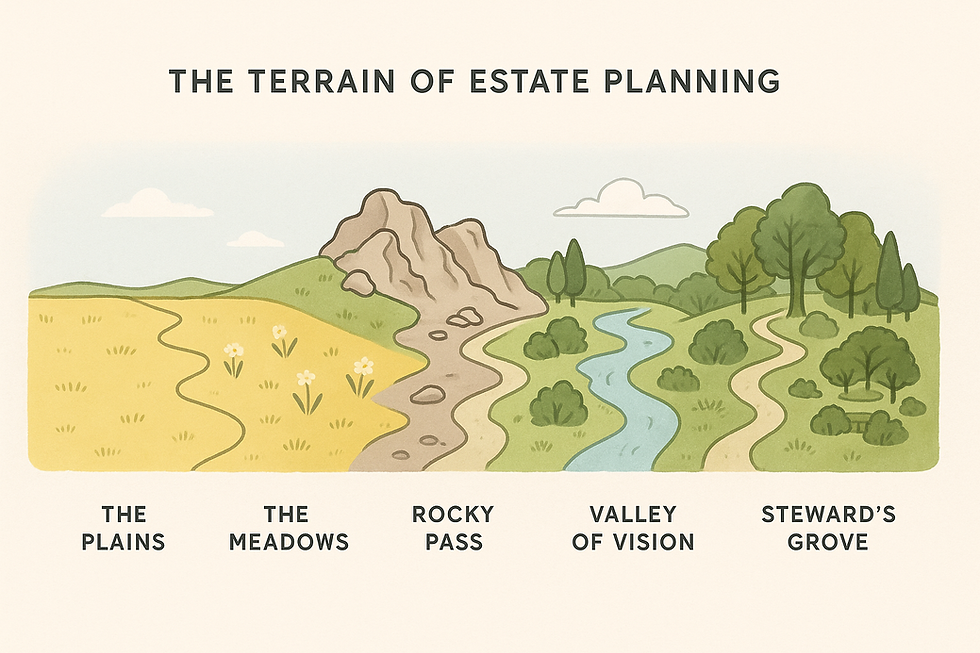Navigating the Terrain of Estate Planning
- macleodmorris
- May 13
- 3 min read
Estate planning is often described in terms of tools: wills, trusts, holding companies. But the real map isn’t built from documents — it’s shaped by intention, relationships, and the kind of legacy you want to leave.
At Strategos, we think of estate planning as a landscape. Some families stick to the well-paved roads of simplicity. Others blaze a trail into more complex territory. And in between? That’s where the terrain gets rugged — full of potential, but also full of risk if you're not prepared.
There’s no single “right” route in estate planning. But knowing where your family is on the map — and what lies ahead — can make all the difference.

Zone 1: The Smooth Plains — Liquidation and Distribution
This is the easiest path to travel. Everything is sold off, and cash is distributed. It’s clear, efficient, and requires little from your heirs beyond signing some paperwork.
The Harrisons: David and Margaret Harrison sold their small manufacturing company before retirement. When they passed away, their estate consisted mostly of cash and investments. Their three children received equal inheritances with no strings attached.
For families looking to keep things simple — or when there’s little interest in shared assets — this flat terrain works just fine. But it rarely creates a lasting legacy.
Zone 2: The Rolling Hills — Simple Legacy, Personal Meaning
A little more intention enters the picture here. Families might earmark gifts for education or donate to causes that matter to them — not complex, but meaningful.
The Campbells: Before they passed, Ian and Rachel Campbell left each of their grandchildren a gift, along with a letter sharing stories from their life and hopes for how the money might help. The estate was simple, but the impact was deeply personal.
These rolling hills don’t require much coordination, but they start to weave in values — and offer a glimpse of deeper planning ahead.
Zone 3: The Rocky Pass — Inherited Assets and Business Transitions
This is where things get tricky. The estate includes something to be kept — a business, a property, or an investment portfolio. Now the terrain changes, and so do the stakes.
The Millers: Robert and Elaine Miller passed down their construction business to their eldest daughter, who had worked in it for years. Their two other children received financial assets. The process created tension — not everyone agreed on what was fair, and the details were hard to manage.
Families crossing this terrain need to navigate uneven ground: sibling dynamics, asset valuations, and management responsibilities. Without preparation, this is where many families stumble.
Zone 4: The Valley of Vision — Shared Purpose and Planning Together
Here, the landscape becomes more collaborative. Families begin to meet, talk, and plan. They build a vision that goes beyond individual inheritances.
The Whitmores: With a growing portfolio of rental properties, the Whitmores started holding annual family retreats. They talked about shared values, personal goals, and future responsibilities. When the parents passed, there was a clear plan — and a family ready to carry it out together.
This valley is wide and fertile, but it takes cultivation. Conversations here can be tough — but they’re where long-term clarity begins to form.
Zone 5: The Stewardship Ridge — Legacy-Minded Families with Strong Governance
Few families set out for this level of terrain, but those who do are building something enduring. They invest in structure, education, and long-term stewardship across generations.
The Westons: Over three generations, the Westons evolved from a thriving family business into a legacy-minded enterprise. They involved all generations in learning, leadership, and planning. Their focus wasn’t just on wealth — it was on identity, responsibility, and purpose.
This ridge isn’t just higher — it’s more connected. Families here act like a team, with clarity around decisions and commitment to something bigger than themselves.
Where Is Your Family on the Map?
Most families don’t realize where they are until they hit the rocky pass. By then, the tension is already rising — and the planning becomes reactive.
But it doesn’t have to be that way. With the right conversations and guidance, you can chart a course that fits your values, your wealth, and your family’s unique shape.
Let’s start mapping it together. Book a call to talk about your current terrain — and where you want to go.




Comments